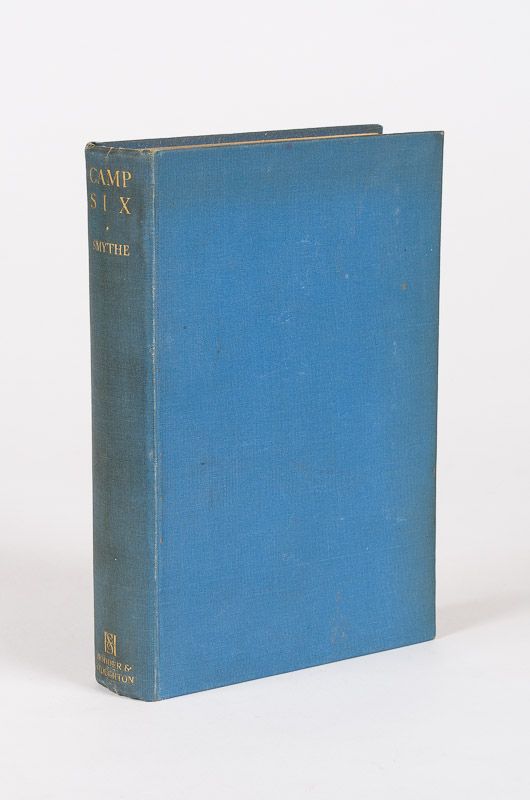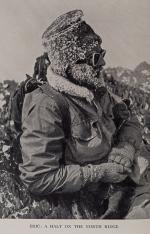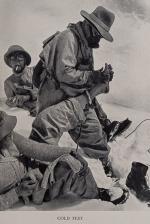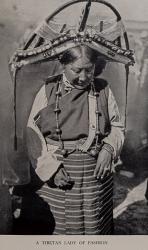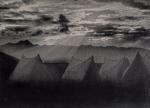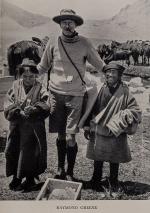Smythe, Camp Six - An Account of the 1933 Mount Everest Expedition.
Camp Six – An Account of the 1933 Mount Everest Expedition.
First edition. London, Hodder and Stoughton, 1937. 15 cm x 22.5 cm. Frontispiece, XI, 307 pages. 36 illustrations including frontispiece. Hardcover [publisher’s original blue cloth] with gilt lettering on spine. Very good+ condition with only minor signs of external wear. Binding very firm. Interior very bright and clean.
Includes, for example, the following: Darjeeling / The Tibetan Plateau / The Base Camp / The North Col / Blizzard at Camp 5 / The Final Attempt etc.
″It is instinctive with man to want to dominate his environment and Everest is one of the last great problems left to him on the surface of this Earth. In solving this problem he adds to his scientific knowledge, and enjoys a physical and spiritual adventure. That Everest will be climbed cannot be doubted; it may be next year or a generation hence” (page X).
The high Tibetan plateau is a harsh environment: “This [biting cold] wind in combination with the sun dries the face until it cracks like the parched mud of a river bed.” (page 45)
Elsewhere he writes “[t]he view from our hill was extraordinary. In every direction rose brown, waterless hills, desolate, windswept hulks of hills possessing neither the beauty of fertility nor the grandeur of the sublime: it was a dead country, fit only for the Wandering Jew and the spirits of the damned.” (page 76)
Smythe offers some criticism of the preparation for the Expedition to Everest. “One of the things that worried me slightly was not knowing for certain with whom I was going to climb on Everest. That few of us were used to climbing together was a serious weakness in the Expedition, and it was a pity that the years between 1924 and 1933 had not been profitably utilised in building up a homogeneous Everest party. To a mountaineer the possibility of having to climb on the highest mountain of the world with someone with whom he has never climbed before is disturbing. A party must move as one man to stand a chance of success.” (p.70-71)
Led by Hugh Ruttledge, the 1933 British Mount Everest expedition was the fourth British expedition to Mount Everest and the first attempt since George Mallory’s ill-fated effort in 1924. Like the previous expeditions to summit the mountain, the 1933 expedition was unsuccessful, although in two separate attempts Lawrence Wager and Percy Wyn-Harris, and then F. S. Smythe, set an altitude record for climbing without supplemental oxygen that was not broken until 1978. During Wager and Wyn-Harris’s attempt, the ice-axe belonging to Andrew Irvine, who disappeared with Mallory on the 1924 attempt while going for the summit, was found on the flanks of the north face (Wikipedia).
Smythe writes eloquently when the realisation that they could not reach the summit could no longer be ignored. He anthropomorphises the mountain, giving it a malign persona: “We were beaten and Everest had no further use for us. Standing humbly on the summit of a peak nearly 23,000 feet high we could only admire the beauty and splendour of our adversary. Everest has been hostile towards us and we had felt that there was something almost personal behind this hostility, in the bitter cold and sudden smiting storms. The air through which we had toiled so painfully had been imbued with some intangible quality opposing our progression, thwarting us with an insidious lethargy, blunting the fine edge of our first enthusiasm. We had felt unwanted; perhaps because we were unworthy.” (p.299) Like much of the writing on mountaineering – and indeed like much of the actual mountaineering – during this period, the mountain was seen as an adversary: an opponent to be bested by means of a military-like campaign or assault. This should come as little surprise given the military experiences and careers of many prominent climbers and due to the lasting impact of the Great War and defusion of military jargon into wider society.
Francis Sydney Smythe, better known as Frank Smythe or F. S. Smythe (1900 – 1949), was an English mountaineer, author, photographer and botanist. He is best remembered for his mountaineering in the Alps as well as in the Himalayas, where he identified a region that he named the “Valley of Flowers”, now a protected park. His ascents include two new routes on the Brenva Face of Mont Blanc, Kamet, and attempts on Kangchenjunga and Mount Everest in the 1930s (Wikipedia).
At the time that Smythe climbed it, Kamet was the highest peak to have been scaled. Smythe’s expeditions resulted in several notable works on mountaineering such as The Kanchenjunga Adventure and Kamet Conquered.
- Keywords: 1930s · Asia · Asia – Rare · British · British History of Climbing · British History of Mountaineering · British Sports · climbing · Expedition · Expeditions · Hiking · Hillwalking · Himalaya · Himalayas · India · Library & Collection Building · Mount Everest · Mountaineer’s Mountain · Mountaineering · Mountaineering – Collection · Mountaineering – Rare · Mountaineers · Mountains · Nature · Nature Photography · Nepal · Outdoors · personal experiences · Personal narratives · Photograph · Photographs · Tibet · Travel · Travel & Expedition – Rare · Travel and Adventure · Travel Asia – Rare · Travel Journal · Travel Writing · Travellers · Travelling Authors
- Language: English
- Inventory Number: 120121AB
© 2024 Inanna Rare Books Ltd. | Powered by HESCOM-Software





